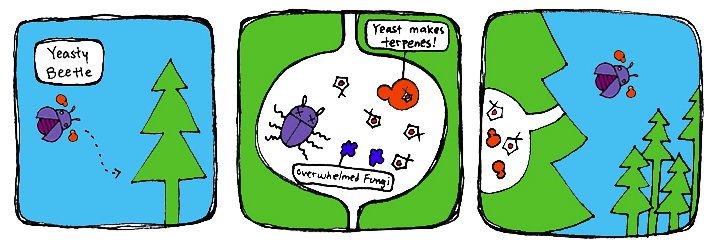Team:British Columbia/Model2
From 2011.igem.org
(→MODEL 2: Dynamics of Mountain Pine Beetle Populations in British Columbia) |
|||
| Line 50: | Line 50: | ||
We simulated the expansion of the MPB population from year 2011 to 2020 using the estimates obtained from the clustering analysis. For cost estimation and prediction of emergence of subpopulations, refer to our Model Methodology above. | We simulated the expansion of the MPB population from year 2011 to 2020 using the estimates obtained from the clustering analysis. For cost estimation and prediction of emergence of subpopulations, refer to our Model Methodology above. | ||
| + | |||
<html><center> | <html><center> | ||
Revision as of 04:39, 29 September 2011

MODEL 2: Dynamics of Mountain Pine Beetle Populations in British Columbia
Modeling the mountain pine beetle epidemic using a probabilistic clustering approach
The Beetle's Strategy
The mountain pine beetle lives in symbiosis with the bluestain fungus which has the ability to break down monoterpenes produced by the tree to deter insect attacks. Their relationship allows the mountain pine beetle to avoid the toxic effects of the monoterpenes, while the bluestain fungus is carried inside the tree where it can happily grow and colonize. The beetles lay their larvae that consume the bluestain fungus for nutrients. Once the larvae grow into adult beetles, they carry the bluestain fungus and infect other trees. Meanwhile, the trees turn red and die because the bluestain fungus blocks transport of water and nutrients throughout the tree. Over the last decade, the pine beetle-bluestain fungus epidemic has spread rapidly through North American pine forests, causing mass destruction to forest health and reliant ecosystems.
Our Theoretical Strategy: iSynthase Trapbox
To restore the levels of monoterpenes in the trees, we propose the introduction of our monoterpene-producing yeast into the environment. Like the beetle's strategy, we will introduce our yeast via trap boxes attracting the beetles by artificial beetle pheromones. Along with the pine beetle infestation, the yeast will be carried by the pine beetle into the trees. Previous studies have shown inhibition of bluestain fungus growth upon interaction with certain concentrations of monoterpenes. Assuming that our yeast does inhibit the growth of bluestain fungus due to the monoterpenes produced, this will also subdue the mountain pine beetle population that depends on the blue-stain fungus. We predict that the spread of our yeast will be similar to the pine-beetle infestation, with the hope that it will spread from beetle to beetle. Therefore, the spread of our yeast product will fall once pine-beetle population declines.
Predictions
We simulated the expansion of the MPB population from year 2011 to 2020 using the estimates obtained from the clustering analysis. For cost estimation and prediction of emergence of subpopulations, refer to our Model Methodology above.
 "
"

